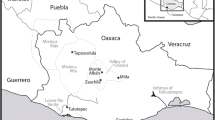Abstract
The origins of lost wax or investment casting, often known as cire perdue, and still the most accurate and reliable means of reproducing complex shapes in gold or other metals with all the fine detail of an original pattern, go back to the very first civilisations in the Near East and to a combination of primitive art, religion and metallurgy. The historical development of the process and its several variations are reviewed here as well as its transmission to other parts of the world.
Similar content being viewed by others
References
P. Amiet, ‘Elam’, Auvers-sur-Oise, 1966, pp. 88–89
L. Bernabo-Brea, ‘Poliochni, Citta Prehistorica Nell ‘Isola di Lemnos’, Rome, 1964, p. 67 and p. 591; K. Branigan, ‘Aegean Metalwork of the Early and Middle Bronze Age’, Oxford, 1974, pp. 77–83
P. Bar-Adon,Isr. Explor. J., 1962,12, 215;Archaeology, 1963,16, 251
Sir Leonard Woolley, ‘Ur Excavations’, Vol. II, London, 1934, p. 78
S. Lloyd, ‘The Archaeology of Mesopotamia’, London, 1978, p. 128
H. Frankfort, Oriental Inst. Pub. 44, Chicago, pp. 39–42
H. Z. Kosay, ‘Alacahüyuk’, Ankara, 1957; E. Akurgal and M. Hirmer, ‘The Art of the Hittites’, London, 1962
T. Özgüc and T. Akok, ‘Horoztepe; An Early Bronze Age Settlement and Cemetery’, Ankara, 1958, p. 47
‘The Dawn of Art’, edited by M. Artamonov, Leningrad, 1974, p. 156
Sir Mortimer Wheeler, ‘The Indus Civilisation’, London, 1968, pp. 90–92; M. S. Vats, ‘Excavations at Harappa’, Vol. I, Delhi, 1940, p. 99; E. J. H. Mackay, ‘Chanhu-daro Excavations’, New Haven, CT., 1943, p. 164
R. A. Higgins, ‘Greek and Roman Jewellery’, London, 1961, pp. 52–53
H. G. Buchholz and V. Karageorghis, ‘Prehistoric Greece and Cyprus’, London, 1973, pp. 101–102
‘Cyprus B.C.’, British Museum, London, 1979, p. 42
H. Limet, ‘Le Travail du Metal au Pays de Sumer au Temps de la IIIe Dynastie d’Ur’, Paris, 1960
M. T. Larsen, ‘The Old Assyrian City-State and its Colonies’, Copenhagen, 1976
M. Schorr, ‘Urkunden des altbabylonischen Zivil und Prozessrechts’, Leipzig, 1913, p. 221; A. Ungnad, ‘Altbabylonische Urkunden’, Leipzig, 1909, p. 103 The writer is indebted to Mr. T. C. Mitchell of the British Museum and to Mr. P. S. Salinger of the School of Oriental and African Studies for these references
Sir Leonard Woolley, ‘Alalakh (Tell Atchana)’, London, 1955
C. C. Mattusch,Hesperia, 1977,46, 380–389
S. I. Rudenko, ‘Frozen Tombs of Siberia’, London, 1970
W. Watson, ‘Cultural Frontiers in Ancient East Asia’, Edinburgh, 1971, pp. 76–77; ‘Arts of the Eurasian Steppelands’, edited by P. Denwood, Percival David Foundation of Chinese Art, London, 1977
P. R. S. Moorey, ‘Catalogue of Ancient Persian Bronzes in the Ashmolean Museum’, Oxford, 1971, pp. 292–295
S. Haynes, ‘Etruscan Sculpture’, ‘Etruscan Bronze Utensils’, British Museum, London, 1971 and 1974
W. Schurmeyer,Dtsch. Goldschmiede Z., 1931,13, 128–132
Professor S. Piggott, private communication
J. M. de Navarro,Antiquity, 1928,2, 423
J. Brailsford and J. E. Stapley,Proc. Prehisl. Soc., 1972,38, 219–234
H. Schliemann, ‘Troy and its Remains’, New York, 1875, p. 173
Sir Leonard Woolley,op. cit., ref. 17, p. 273
J. V. Canby,Iraq, 1965,27, 1
R. F. Tylecote, ‘Metallurgy in Archaeology’, London, 1962, pp. 125–128
Professor S. Piggott, private communication
K. R. Maxwell-Hyslop and W. H. M. Hodges,Iraq, 1964,26, 50–53
J. Ternbach,Expedition, 1970,12, (3), 41–42
A. Oldeberg, ‘Metallteknik under Vikingatio och Medelted’, Stockholm, 1966, pp. 256–260
G. Wainwright and M. Spratling,Antiquity, 1973,47, 109–130
J. Foster, British Museum Occasional Papers No. 12, London, 1980 I am grateful to Miss Foster for allowing me access to this paper before its publication.
Sir John Marshall, ‘Taxilia’, Vol. II, Cambridge, 1951, pp. 616–621
M. V. Krishnan, ‘Cire Perdue Casting in India’, New Delhi, 1976; S. K. Saraswati,J. Indian Soc. Orient. Art, 1936,IV, (2), 139
J. Rafters, ‘Prehistoric Ireland’, London, 1951; F. Henry, ‘Irish Art in the Early Christian Period’, London, 1947; A. Mahr, ‘Christian Art in Ancient Ireland’, Vol. II, Dublin, 1941, p. 41
L. Laing, ‘The Archaeology of Late Celtic Britain and Ireland’, London, 1975, p. 253
B. Arrhenius, in ‘Gold Age and Viking Art in Sweden’, Stockholm, 1965
J. G. Hawthorne and C. S. Smith, ‘On Divers Arts, The Treatise of Theophilus’, Chicago, 1963; C. R. Dodwell,Gold Bull., 1971,4, (3), 51–55
C. Oman, ‘The Gloucester Candlestick’, Victoria and Albert Museum, London, 1958
A. Ratcliffe, ‘European Bronze Statuettes’, London, 1966
C. R. Ashbee (transl.), ‘The Treatises of Benvenuto Cellini on Goldsmithing and Sculpture’, London, 1888
G. F. Hill, ‘Medals of the Renaissance’, Oxford, 1920, pp. 19–30
R. Weiss, ‘Pisanello’s Medallion of the Emperor John VIII Palaeologus’, British Museum, London, 1966
J. F. Hayward, ‘Virtuoso Goldsmiths and the Triumph of Mannerism’, London, 1976
W. Bray,Proc. R. Anthropol. Ina. 1971, 1972, 25–43;Gold Bull, 1978,11, (4), 136–143
‘The Gold of El Dorado’, Royal Academy of Arts, London, 1978; ‘El Dorado Colombian Gold’, Australian Art Exhibitions Corp., Sydney, 1978; ‘El Dorado — Der Traum vom Gold’, Hanover, 1979
A.-M. Falchetti, ‘The Goldwork of the Sinú Region, Northern Colombia’, M. Phil. Dissertation, University of London Institute of Archaeology, 1976
D. Williams, ‘Icon and Image’, London, 1974
W. H. Taggart,Dent. Cosmos, 1907,49, 1117–1121
T. G. Jungersen, British Patent 449 062 (1936)
P. E. Gainsbury,Gold Bull, 1979,12, (1), 2–8
Author information
Authors and Affiliations
Rights and permissions
About this article
Cite this article
Hunt, L.B. The long history of lost wax casting. Gold Bull 13, 63–79 (1980). https://doi.org/10.1007/BF03215456
Issue Date:
DOI: https://doi.org/10.1007/BF03215456




